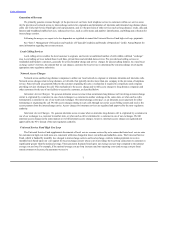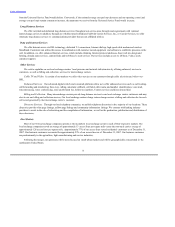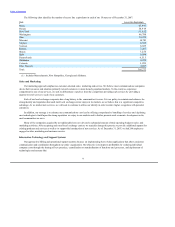FairPoint Communications 2007 Annual Report Download - page 19
Download and view the complete annual report
Please find page 19 of the 2007 FairPoint Communications annual report below. You can navigate through the pages in the report by either clicking on the pages listed below, or by using the keyword search tool below to find specific information within the annual report.
Table of Contents
transmission services that are used as an input to Internet access services through private carriage arrangements on negotiated commercial
terms. The FCC order also allows rate-of-return carriers the option to continue providing DSL service as a common carrier (status quo)
offering.
In addition, a Verizon petition asking the FCC to forbear from applying common carrier regulation to certain broadband services
sold primarily to larger business customers when those services are not used for Internet access was deemed granted by operation of law
on March 19, 2006 when the FCC did not deny the petition by the statutory deadline. The U.S. Court of Appeals for the District of
Columbia Circuit has rejected a challenge to that outcome.
The FCC has imposed particular regulatory obligations on broadband services. It has concluded that interconnected VoIP providers
and broadband Internet access providers must comply with CALEA. The FCC has also required interconnected VoIP providers to provide
enhanced 911 emergency calling capabilities, to comply with certain disability access requirements, to comply with the FCC’s rules
protecting CPNI, and to provide local number portability. Recently there have also been discussions among policymakers concerning “net
neutrality,” or the potential requirement for non-discriminatory treatment of traffic over broadband networks. The FCC has sought
comment on industry practices in connection with this issue. However, we cannot predict what impact, if any, this may have on our
business. Finally the FCC has preempted some state regulation of VoIP.
Following the transactions, because our non-rural operations will be classified as a Bell Operating Company, they will be subject to
additional requirements in connection with their provision of enhanced services. Specifically, our non-rural operations generally must
provide enhanced services consistent with the FCC’s so-called rules, which require each Bell Operating Company to
ensure that unaffiliated enhanced service providers have nondiscriminatory access to the telecommunications transmission capability
underlying any enhanced services provided by the Bell Operating Company, except for where the FCC specifically has provided relief
from some or all of these requirements.
Additional rules and regulations may be extended to the Internet. A variety of proposals are under consideration in both federal and
state legislative and regulatory bodies. We cannot predict whether the outcome of pending or future proceedings will prove beneficial or
detrimental to our competitive position.
The local service rates and intrastate access charges of substantially all of our telephone subsidiaries will be regulated by state
regulatory commissions which typically have the power to grant and revoke franchises authorizing companies to provide communications
services. In some states, our intrastate long-distance rates are also subject to state regulation. States typically regulate local service quality,
billing practices and other aspects of our business as well.
Most state commissions have traditionally regulated local exchange carrier pricing through cost-based “rate-of-return” regulation. In
recent years, however, state legislatures and regulatory commissions in most of the states in which our telephone companies operate have
either reduced the regulation of local exchange carriers or have announced their intention to do so, and we expect this trend will continue.
Such relief may take the form of mandatory deregulation of particular services or rates; or it may consist of optional alternative forms of
regulation, referred to as AFOR, which may involve price caps or other flexible pricing arrangements. Some of these deregulatory
measures are described in greater detail below. We believe that some AFOR plans allow us to offer new and competitive services faster than
under the traditional regulatory regimes.
The following summary addresses significant regulatory actions by regulatory agencies in Maine, New Hampshire and Vermont that
have affected or are expected to affect the Northern New England business:
The parties to the merger have received the orders, dated February 1, 2008, February 15, 2008 and February 25, 2008, of
applicable state regulatory authorities in Maine, Vermont and New Hampshire, respectively, in each case approving the transactions,
subject to certain conditions.
17
























